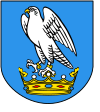 Alternate names: Sokoły [Pol], Sokoli, סאקאלי [Yid], Соколы [Rus]. 52°59' N, 22°42' E, 9 miles NE of Wysokie Mazowieckie, 21 miles SW of of the regional capital Białystok, 29 miles ESE of Łomża. 1900 Jewish population: 1,723. Yizkors: Sokoly-be-ma'avak le-hayim (Tel Aviv, 1975) and Sefer Zikaron le-kedoshei Sokoly (Tel Aviv, 1962). Gmina Sokoły is a rural administrative district in Wysokie Mazowieckie powiat, Podlaskie Voivodeship in NE Poland. with its seat in the village of Sokoły, 15 kilometres (9 mi) north-east of Wysokie Mazowieckie and 35 km (22 mi) south-west Białystok. The gmina 2006 total population was 5,952. Gmina Sokoły contains the villages and settlements of Bruszewo, Bruszewo-Borkowizna, Bujny, Chomice, Czajki, Drągi, Dworaki-Pikaty, Dworaki-Staśki, Idźki Młynowskie, Idźki Średnie, Idźki-Wykno, Jabłonowo-Kąty, Jabłonowo-Wypychy, Jamiołki-Godzieby, Jamiołki-Kowale, Jamiołki-Piotrowięta, Jamiołki-Świetliki, Jeńki, Kowalewszczyzna, Kowalewszczyzna-Folwark, Kruszewo-Brodowo, Kruszewo-Głąby, Kruszewo-Wypychy, Krzyżewo, Mojsiki, Noski Śnietne, Nowe Racibory, Perki-Bujenki, Perki-Franki, Perki-Karpie, Perki-Lachy, Perki-Mazowsze, Perki-Wypychy, Pęzy, Porośl-Kije, Roszki-Chrzczony, Roszki-Leśne, Roszki-Sączki, Roszki-Ziemaki, Rzące, Sokoły, Stare Racibory, Stare Truskolasy, Truskolasy-Lachy, Truskolasy-Niwisko, Truskolasy-Olszyna, Truskolasy-Wola and Waniewo. [July 2009]
Alternate names: Sokoły [Pol], Sokoli, סאקאלי [Yid], Соколы [Rus]. 52°59' N, 22°42' E, 9 miles NE of Wysokie Mazowieckie, 21 miles SW of of the regional capital Białystok, 29 miles ESE of Łomża. 1900 Jewish population: 1,723. Yizkors: Sokoly-be-ma'avak le-hayim (Tel Aviv, 1975) and Sefer Zikaron le-kedoshei Sokoly (Tel Aviv, 1962). Gmina Sokoły is a rural administrative district in Wysokie Mazowieckie powiat, Podlaskie Voivodeship in NE Poland. with its seat in the village of Sokoły, 15 kilometres (9 mi) north-east of Wysokie Mazowieckie and 35 km (22 mi) south-west Białystok. The gmina 2006 total population was 5,952. Gmina Sokoły contains the villages and settlements of Bruszewo, Bruszewo-Borkowizna, Bujny, Chomice, Czajki, Drągi, Dworaki-Pikaty, Dworaki-Staśki, Idźki Młynowskie, Idźki Średnie, Idźki-Wykno, Jabłonowo-Kąty, Jabłonowo-Wypychy, Jamiołki-Godzieby, Jamiołki-Kowale, Jamiołki-Piotrowięta, Jamiołki-Świetliki, Jeńki, Kowalewszczyzna, Kowalewszczyzna-Folwark, Kruszewo-Brodowo, Kruszewo-Głąby, Kruszewo-Wypychy, Krzyżewo, Mojsiki, Noski Śnietne, Nowe Racibory, Perki-Bujenki, Perki-Franki, Perki-Karpie, Perki-Lachy, Perki-Mazowsze, Perki-Wypychy, Pęzy, Porośl-Kije, Roszki-Chrzczony, Roszki-Leśne, Roszki-Sączki, Roszki-Ziemaki, Rzące, Sokoły, Stare Racibory, Stare Truskolasy, Truskolasy-Lachy, Truskolasy-Niwisko, Truskolasy-Olszyna, Truskolasy-Wola and Waniewo. [July 2009]
The first Jews probably settled in Sokoly at the end of 17th century. By 1764, 163 Jews lived there surely with a cemetery and probably with a synagogue. In the 1860s, the St. Petersburg-Warsaw railway encouraged rabid growth of the city when 4,000 Jews lived there with three synagogue, one brick. A government-sponsored loss of civic rights, restored only in 1915 by the German occupiers, occurred when the Jews were 70% of the population. Difficult economic conditions of the end of the 19th century and early 20th, WWI, increased anti-Semitism resulted in a decrease in population as the Jews moved to larger cities or immigrated. From September 1939, Soviet troops occupied until in June 1941 when the Germans occupied and set up a ghetto in August that existed until November 1, 1942 when the inhabitants were transported to Bialystok and later to Treblinka.
MASS GRAVE: On November 1, 14 Jews, possibly 20, were shot and buried in a mass grave in the Jewish cemetery.. Shortly after the end of the war, a handful of survivors returned to the town. In February 1945, an armed band murdered seven of them (Szamaj Litwak, Szyjke Litwak, Tolka Żytawer, Dawid Żółty, Basia Wajnsztajn, Dawid Kaszczewski, Szajna Olszak). The youngest victim was four years old.
OLD CEMETERY: The kahal had two cemetery, the oldest of which was founded in the 18th century on the current square Mickiewicza was closed at the end of the 19th century. The gravestones were so old that some had sunk into the ground, their inscriptions illegible. Several were marble. An ohel of Gutman was there.
CEMETERY: The second cemetery, on today's ½ Sokołach Street was quite large. During WWII, isolated executions of local Jews as well as Poles occurred. Until the 1950s, gravestones still remained. The stone building was razed for a cow pasture and dump and later a football field. People came from far and near to take those valuable granite gravestones. In 1991, under a komunalizacyjnej Wojewoda Łomżyńskiego decision, the area was handed over to the city of Sokoly. In 2002, the Republic of Poland asked for the return of the land of the cemetery. The case is still pending. photos. photos. [July 2009]
